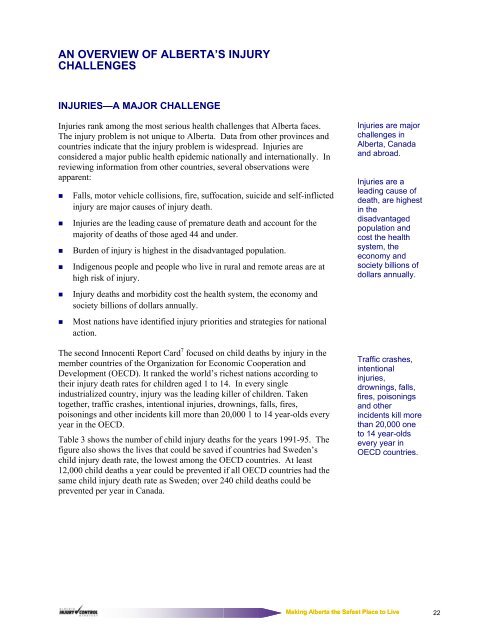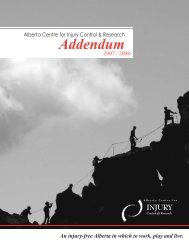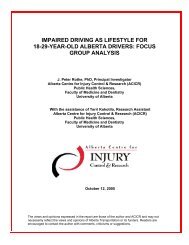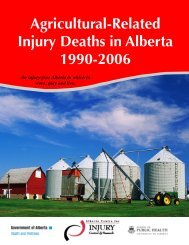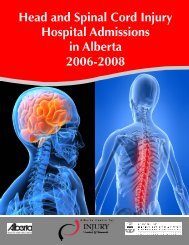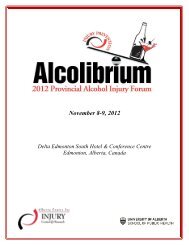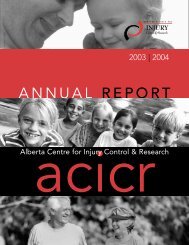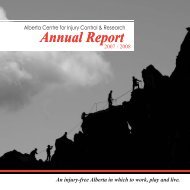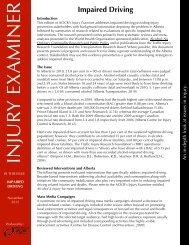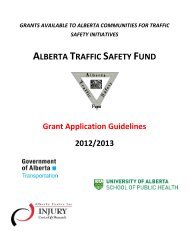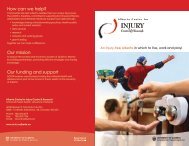JUNE 2003 - Alberta Centre for Injury Control & Research
JUNE 2003 - Alberta Centre for Injury Control & Research
JUNE 2003 - Alberta Centre for Injury Control & Research
Create successful ePaper yourself
Turn your PDF publications into a flip-book with our unique Google optimized e-Paper software.
AN OVERVIEW OF ALBERTA’S INJURY<br />
CHALLENGES<br />
INJURIES—A MAJOR CHALLENGE<br />
Injuries rank among the most serious health challenges that <strong>Alberta</strong> faces.<br />
The injury problem is not unique to <strong>Alberta</strong>. Data from other provinces and<br />
countries indicate that the injury problem is widespread. Injuries are<br />
considered a major public health epidemic nationally and internationally. In<br />
reviewing in<strong>for</strong>mation from other countries, several observations were<br />
apparent:<br />
• Falls, motor vehicle collisions, fire, suffocation, suicide and self-inflicted<br />
injury are major causes of injury death.<br />
• Injuries are the leading cause of premature death and account <strong>for</strong> the<br />
majority of deaths of those aged 44 and under.<br />
• Burden of injury is highest in the disadvantaged population.<br />
• Indigenous people and people who live in rural and remote areas are at<br />
high risk of injury.<br />
• <strong>Injury</strong> deaths and morbidity cost the health system, the economy and<br />
society billions of dollars annually.<br />
• Most nations have identified injury priorities and strategies <strong>for</strong> national<br />
action.<br />
The second Innocenti Report Card 7 focused on child deaths by injury in the<br />
member countries of the Organization <strong>for</strong> Economic Cooperation and<br />
Development (OECD). It ranked the world’s richest nations according to<br />
their injury death rates <strong>for</strong> children aged 1 to 14. In every single<br />
industrialized country, injury was the leading killer of children. Taken<br />
together, traffic crashes, intentional injuries, drownings, falls, fires,<br />
poisonings and other incidents kill more than 20,000 1 to 14 year-olds every<br />
year in the OECD.<br />
Table 3 shows the number of child injury deaths <strong>for</strong> the years 1991-95. The<br />
figure also shows the lives that could be saved if countries had Sweden’s<br />
child injury death rate, the lowest among the OECD countries. At least<br />
12,000 child deaths a year could be prevented if all OECD countries had the<br />
same child injury death rate as Sweden; over 240 child deaths could be<br />
prevented per year in Canada.<br />
Injuries are major<br />
challenges in<br />
<strong>Alberta</strong>, Canada<br />
and abroad.<br />
Injuries are a<br />
leading cause of<br />
death, are highest<br />
in the<br />
disadvantaged<br />
population and<br />
cost the health<br />
system, the<br />
economy and<br />
society billions of<br />
dollars annually.<br />
Traffic crashes,<br />
intentional<br />
injuries,<br />
drownings, falls,<br />
fires, poisonings<br />
and other<br />
incidents kill more<br />
than 20,000 one<br />
to 14 year-olds<br />
every year in<br />
OECD countries.<br />
Making <strong>Alberta</strong> the Safest Place to Live<br />
22


